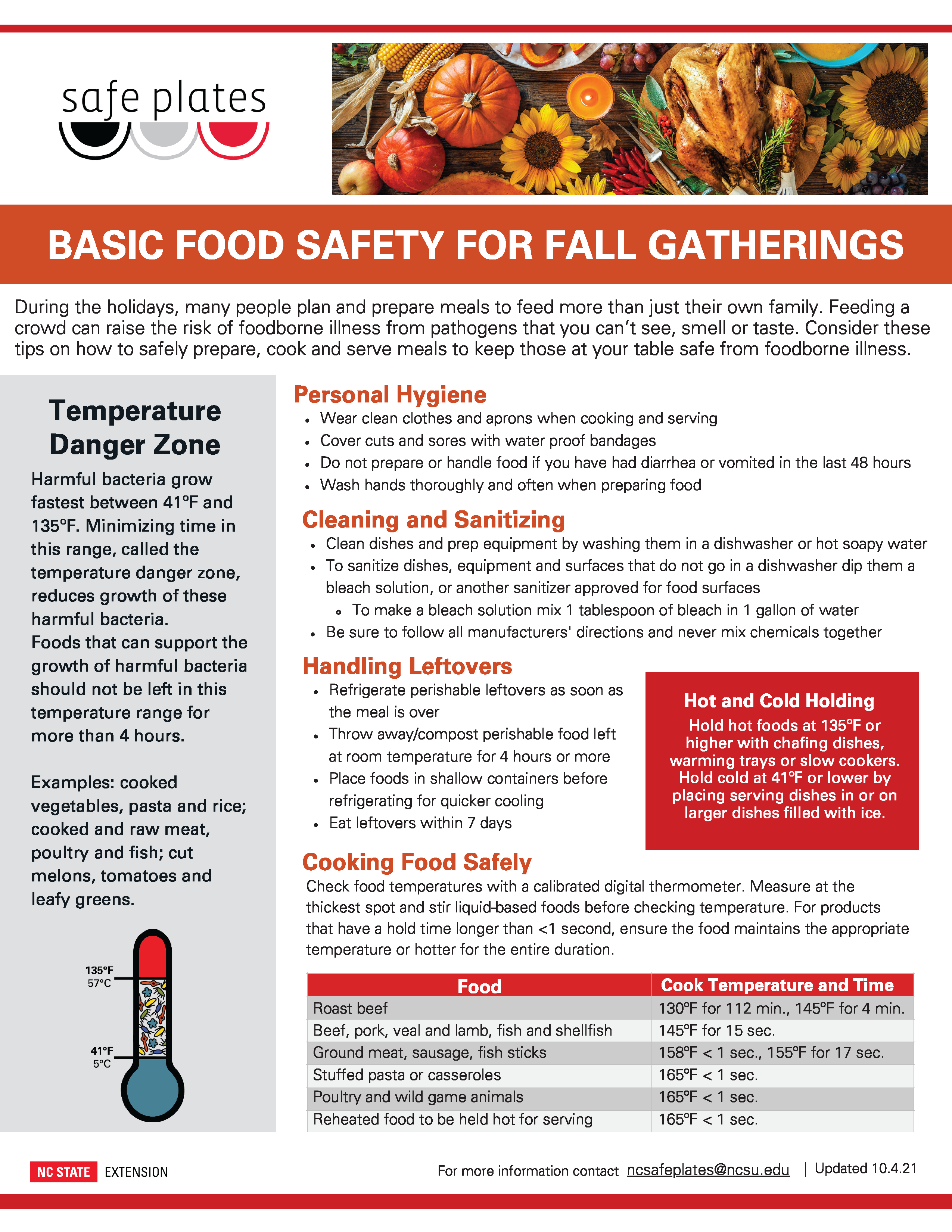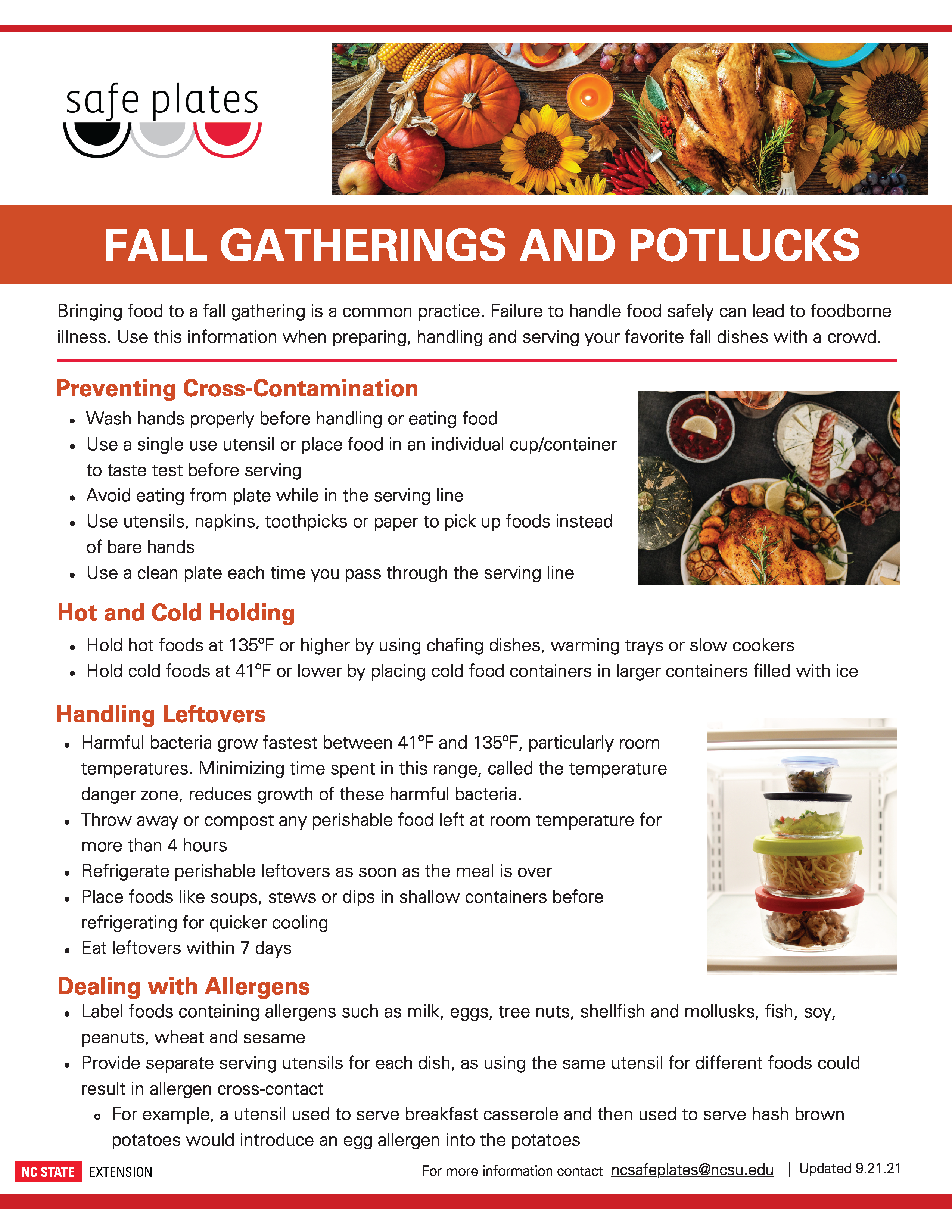Basic Food Safety for Fall Gatherings
go.ncsu.edu/readext?833751
en Español / em Português
El inglés es el idioma de control de esta página. En la medida en que haya algún conflicto entre la traducción al inglés y la traducción, el inglés prevalece.
Al hacer clic en el enlace de traducción se activa un servicio de traducción gratuito para convertir la página al español. Al igual que con cualquier traducción por Internet, la conversión no es sensible al contexto y puede que no traduzca el texto en su significado original. NC State Extension no garantiza la exactitud del texto traducido. Por favor, tenga en cuenta que algunas aplicaciones y/o servicios pueden no funcionar como se espera cuando se traducen.
Português
Inglês é o idioma de controle desta página. Na medida que haja algum conflito entre o texto original em Inglês e a tradução, o Inglês prevalece.
Ao clicar no link de tradução, um serviço gratuito de tradução será ativado para converter a página para o Português. Como em qualquer tradução pela internet, a conversão não é sensivel ao contexto e pode não ocorrer a tradução para o significado orginal. O serviço de Extensão da Carolina do Norte (NC State Extension) não garante a exatidão do texto traduzido. Por favor, observe que algumas funções ou serviços podem não funcionar como esperado após a tradução.
English
English is the controlling language of this page. To the extent there is any conflict between the English text and the translation, English controls.
Clicking on the translation link activates a free translation service to convert the page to Spanish. As with any Internet translation, the conversion is not context-sensitive and may not translate the text to its original meaning. NC State Extension does not guarantee the accuracy of the translated text. Please note that some applications and/or services may not function as expected when translated.
Collapse ▲THANKSGIVING TURKEY FOOD SAFETY
Having a turkey on your Thanksgiving table is a timeless American tradition. Use this information when purchasing, preparing, handling and serving your Thanksgiving turkey.
BUYING YOUR THANKSGIVING TURKEY
Fresh Turkey
- Check packaging for leaks and separate from other items in the cart
- Leave turkey in bag and place in a pan or on a tray to prevent dripping
- Store on bottom shelf of fridge at or below 41°F
Frozen Turkey
- Keep turkey in the freezer
(0°F) until it’s ready to thaw and be cooked - Thawing in refrigerator will take ~24 hours for every 5 pounds
If you receive a donated fresh or frozen turkey from a food pantry, non-profit organization, etc. past it’s expiration date, it is still safe to eat, if handled and cooked properly.
Thawing
- Thaw turkey quickly with the following methods:
- Cool water: Submerge in sink or container of cool water, changing every 30 minutes. Allow 30 minutes per pound.
- Microwave: Read manual instructions. Remove wrapping. Rotate several times. Cook turkey immediately after thawing. Allow 6 minutes per pound.
- Cook: Use method if turkey is partially thawed. Allow at least 50% longer time to cook through.
Preparing
- You do not need to wash your turkey. Washing raw poultry won’t kill bacteria, but cooking to the proper internal temperature will. However, when washing, harmful bacteria like Salmonella and Campylobacter can be sprayed up to 3 feet on nearby surfaces.
- To prevent the spread of bacteria, clean and sanitize utensils and work surfaces and wash hands after preparing raw poultry.
Cooking
. When the juices run clear or the turkey is a golden brown color it does not necessarily indicate the turkey is done. The only way to tell is by using a verified food thermometer to check the internal temperature.
- Poultry, like turkey and chicken, must be cooked to an internal temperature of at least 165°F for safety. Check temperature in three spots includina:
- Thickest part of the breast
- Innermost part of the wing
- Innermost part of the thigh
- For safety, stuffing must also reach 165°F checked in multiple places.
This could cause the turkey to be cooked to over 165°F. - To avoid overcooking, consider making stuffing separately
BASIC FOOD SAFETY FOR FALL GATHERINGS
During the holidays, many people plan and prepare meals to feed more than just their own family. Feeding a crowd can raise the risk of foodborne illness from pathogens that you can’t see, smell or taste. Consider these tips on how to safely prepare, cook and serve meals to keep those at your table safe from foodborne illness.
Personal Hygiene
- Wear clean clothes and aprons when cooking and serving
- Cover cuts and sores with water proof bandages
- Do not prepare or handle food if vou have had diarrhea or vomited in the last 48 hours
- Wash hands thoroughly and often when preparing food
Cleaning and Sanitizing
- Clean dishes and prep equipment by washing them in a dishwasher or hot soapy water
- To sanitize dishes, equipment and surfaces that do not go in a dishwasher dip them a bleach solution, or another sanitizer approved for food surfaces
- To make a bleach solution mix 1 tablespoon of bleach in 1 gallon of water
- Be sure to follow all manufacturers’ directions and never mix chemicals together
Handling Leftovers
- Refrigerate perishable leftovers as soon as the meal is over
- Throw away/compost perishable food left at room temperature for 4 hours or more
- Place foods in shallow containers before refrigerating for quicker cooling
- Eat leftovers within 7 days
Hot and Cold Holding
Hold hot foods at 135°F or higher with chafing dishes, warming trays or slow cookers. Hold cold at 41°F or lower by placing serving dishes in or on larger dishes filled with ice.
Cooking Food Safely
Check food temperatures with a calibrated digital thermometer. Measure at the thickest spot and stir liquid-based foods before checking temperature. For products that have a hold time longer than <1 second, ensure the food maintains the appropriate temperature or hotter for the entire duration.
|
Food |
Cook Temperature and Time |
|
Roast beef |
130°F for 112 min., 145°F for 4 min. |
|
Beef, pork, veal and lamb, fish and shellfish |
145°F for 15 sec. |
|
Ground meat, sausage, fish sticks |
158F < 1 sec., 155°F for 17 sec. |
|
Stuffed pasta or casseroles |
165°F < 1 sec. |
|
Poultry and wild game animals |
165°F < 1 sec. |
|
Reheated food to be held hot for serving |
165°F < 1 sec |
Temperature Danger Zone
Harmful bacteria grow fastest between 41°F and 135°F. Minimizing time in this range, called the temperature danger zone, reduces growth of these harmful bacteria.
Foods that can support the growth of harmful bacteria should not be eft in this temperature range for more than 4 hours.
Examples: cooked vegetables, pasta and rice; cooked and raw meat, poultry and fish; cut melons, tomatoes and leafy greens.
FALL GATHERINGS AND POTLUCKS
Bringing food to a fall gathering is a common practice. Failure to handle food safely can lead to foodborne illness. Use this information when preparing, handling and serving your favorite fall dishes with a crowd.
Preventing Cross-Contamination
Wash hands properly before handling or eating food
- Use a single use utensil or place food in an individual cup/container to taste test before serving
Avoid eating from plate while in the serving line - Use utensils, napkins, toothpicks or paper to pick up foods instead of bare hands
- Use a clean plate each time vou pass through the serving line
Hot and Cold Holding
- Hold hot foods at 135°F or higher by using chafing dishes, warming trays or slow cookers
- Hold cold foods at 41°F or lower by placing cold food containers in larger containers filled with ice
Handling Leftovers
- Harmful bacteria grow fastest between 41°F and 135°F, particularly room temperatures. Minimizing time spent in this range, called the temperature danger zone, reduces growth of these harmful bacteria.
- Throw away or compost any perishable food left at room temperature for more than 4 hours
- Refrigerate perishable leftovers as soon as the meal is over
- Place foods like soups, stews or dips in shallow containers before refrigerating for quicker cooling
- Eat leftovers within 7 days
Dealing with Allergens
- Label foods containing allergens such as milk, eggs, tree nuts, shellfish and mollusks, fish, soy, peanuts, wheat and sesame
- Provide separate serving utensils for each dish, as using the same utensil for different foods could result in allergen cross-contact.
- For example, a utensil used to serve breakfast casserole and then used to serve hash brown potatoes would introduce an egg allergen into the potatoes
For more information contact ncsafeplates@ncsu.edu.







